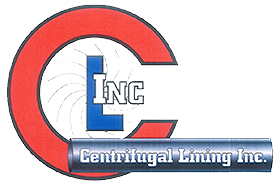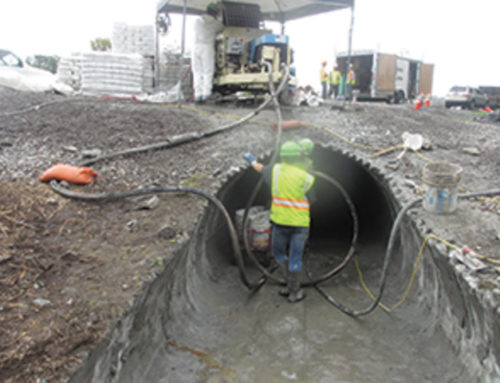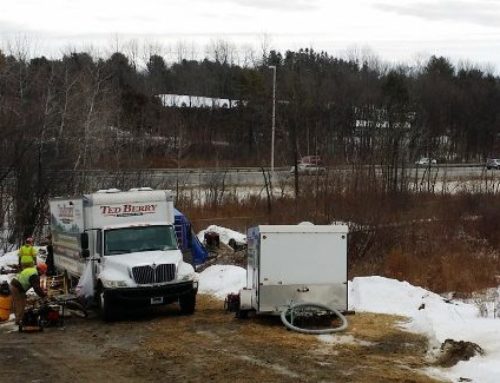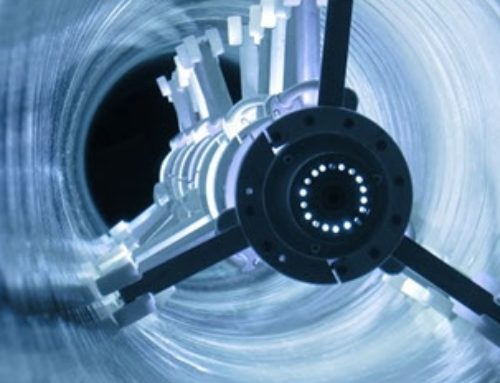By Angus W. Stocking
Otay Landfill, in Chula Vista, Calif., near San Diego, is operated by Republic Services, a sustainably minded provider of solid waste collection, transfer, recycling, and disposal services. The company is noted for its commitment to solar power, and in 2010 dedicated the world’s largest solar landfill cover, a $5 million project that generates a megawatt of clean electricity.
When Republic Services staff were faced with a difficult stormwater sewer challenge at Otay, they sought out the best available rehabilitation technology. For this project, that proved to be Centri-Pipe, a centrifugally cast concrete pipe (CCCP) repair system that is emerging as a best practice for large diameter pipe in need of structural repair and waterproofing.
 |
| Three passes were required to complete the lining project. The result was a clean pipe that only reduced the sewer’s inner diameter by 2.5 inches. |
“We noticed severe erosion around a pipe inlet, and we knew we had a problem,” said Environmental Specialist W. Tyler Overton, “And when we inspected we found severe failure and erosion in most of the pipe.”
This was about 200 feet of 48-inch corrugated metal pipe (CMP); rust had nearly destroyed much of the invert and eroded large cavities in the sandy bedding soil. Trenching and replacing was considered and quickly rejected.
“The pipe was fairly deep, anywhere from 8 to 20 feet,” Overton said, “but the bigger problem was that it ran beneath sedimentation ponds that we didn’t want to disturb.”
In addition to disrupting operations, trenching would destroy carefully engineered and constructed ponds that were working well. A nearby concrete aggregate plant was also a factor; trenching could disturb large gravel stockpiles and they would be difficult to work around.
Liners and sliplining were also eliminated. A 45-degree bend halfway through the pipe made sliplining difficult and most liners wouldn’t provide the structural repair that was needed.
Overton had learned about Centri-Pipe in a trade journal, and talked directly with the providers, AP/M Permaform, about the possibilities at Otay.
“Joe Cherry at AP/M described the process and created a proposal for us,” Overton said.
Spincast Repair
Centri-Pipe uses a precisely controlled spincaster to apply thin layers of high-strength grouts that seal existing sewers and adhere tightly to the existing substrate, which can be any round or elliptical pipe including CMP, concrete, clay, brick, etc. In essence, the system casts a new, thin-walled pipe that matches the contours of the existing pipe, even if the pipe is failing.
The spincaster and an operator are inserted into horizontal pipe and then withdrawn by winch at calculated speeds — runs of more than 400 feet are possible. While the spincaster is withdrawn, the operator visually confirms adherence and layer thickness, and adjusts the withdrawal speed as needed. Typically, three to five layers are applied to build up thicknesses specified by AP/M Permaform’s engineers.

| Rust had nearly destroyed much of the invert. Eroded voids were filled with sand and grout, and a new grout invert was poured. |
Prep work is basic, but can’t be skipped. In this case, the work was done during a dry time of year and a simple cofferdam was enough diversion for potential stormwater. The pipe invert must be flat enough to allow the spincaster to be withdrawn smoothly, without jerking that would cause uneven grout application. In the case of the Otay Landfill storm sewer, that required filling of the eroded voids with sand and grout, and the pouring of a new grout invert.
PL-8000, made by AP/M Permaform, was used for the invert and the spincasting. The product is a cementitious, fiber-reinforced mortar with excellent properties for CCCP including high strength, quick curing, adherence in moist conditions, and resistance to rust and corrosion.
The pipe above the invert was also repaired as needed to serve as a reasonably firm substrate for the new grout layers, and the corrugated metal pipe was pressure-washed to remove tar and dirt that could affect grout adherence.
With prep work done, the Otay Landfill project became a straightforward CCCP project. The AP/M Permaform crew worked from riser to riser, with a longest pull of about 150 feet. A total of three layers were applied, for a total thickness of 1.25 inches. When working with CMP, as on this project, special effort is made on the first layers to “flatten” the corrugations; this way, the final layer is uniform and smooth.
To guarantee quality and correct application, AP/M Permaform crews check layer thickness with a gauge during the run, and video the entire pipe before and after application.
With prep work and three passes, total time on site was eight days. The result was a clean, strong, rustproof pipe that only reduced the sewer’s inner diameter by 2.5 inches.
“This was cost effective, especially compared to trenching,” Overton said, “And the quality of the rehabilitation exceeded our expectations.”





